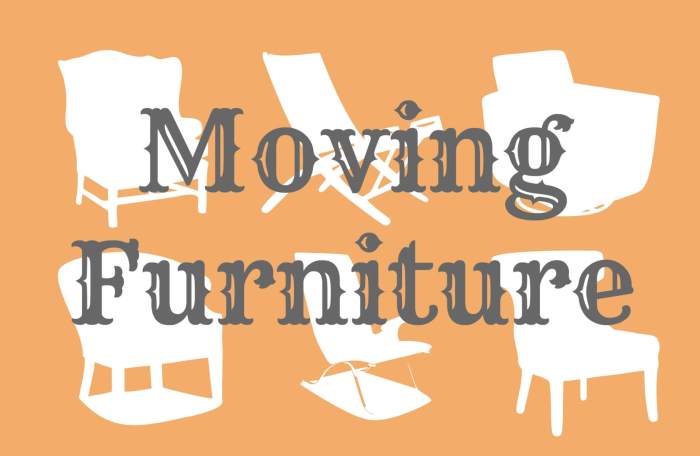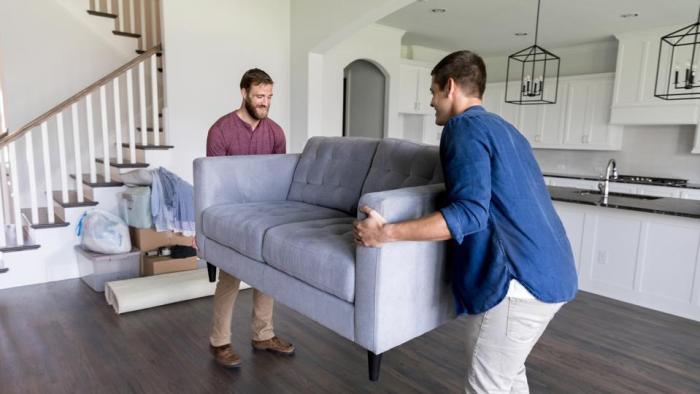Moving of furniture – Moving furniture can be a daunting task, but with the right planning and techniques, it can be a breeze. This comprehensive guide will walk you through every step of the process, from planning and preparation to lifting and transporting, ensuring your furniture arrives at its new home safely and in style.
Whether you’re a seasoned mover or a first-timer, this guide has something for everyone. We’ll cover everything from essential tools and materials to packing and protection, so you can rest assured that your furniture will be well-protected during the move.
Planning and Preparation
Moving furniture can be a daunting task, but with careful planning and preparation, it can be a smooth and efficient process. Here are some essential steps to ensure a successful move:
Decluttering and Organization
Before you start packing, it’s crucial to declutter and organize your belongings. Get rid of anything you no longer need or use, such as old clothes, broken items, or unused furniture. This will reduce the amount of stuff you have to move and make packing and unpacking easier.
Tools and Materials
Gather all the necessary tools and materials you’ll need for moving, including:
- Moving boxes in various sizes
- Packing tape
- Bubble wrap or packing paper
- Markers or labels
- Scissors
- Dismantling tools (e.g., screwdrivers, wrenches)
- Dolly or hand truck
- Furniture pads or blankets
- First-aid kit
Furniture Disassembly and Assembly

Before moving, it’s essential to disassemble furniture to ensure safe transportation and ease of reassembly. Identify pieces that require disassembly, such as beds, tables, and dressers. Follow proper techniques to prevent damage during the process.
Handling Delicate Furniture Items
- Wrap fragile pieces in protective materials like bubble wrap or moving blankets.
- Disassemble mirrors and glass components carefully, using gloves and protective gear.
- Handle antique or valuable furniture with extreme care, seeking professional assistance if necessary.
Handling Heavy Furniture Items
- Lift heavy furniture with proper lifting techniques, bending your knees and keeping your back straight.
- Use dollies or furniture sliders to move heavy items safely without causing damage to floors or furniture.
- Secure heavy furniture securely in the moving vehicle to prevent shifting during transit.
Packing and Protection

Protecting furniture during transport is crucial to prevent damage. Use appropriate packing materials and techniques, such as bubble wrap, packing paper, foam sheets, and cardboard boxes. Wrap each item securely, ensuring no exposed surfaces. Cushion fragile items with soft materials like towels or blankets.
Moving furniture can be a daunting task, but it doesn’t have to be. With the right planning and preparation, you can make the process as smooth and stress-free as possible. One of the most important steps is to find the right furniture store.
Raymour & Flanigan is a great option, with locations all across the country. They have a wide selection of furniture to choose from, and their staff is always happy to help you find the perfect pieces for your home. Once you’ve found the right furniture, the next step is to start packing.
Be sure to label all of your boxes so you know where everything is when you get to your new home. With a little planning and preparation, moving furniture can be a breeze.
Specialized Packing Supplies
Consider using specialized packing supplies like moving blankets and furniture covers. Moving blankets are thick, padded covers that protect furniture from scratches and dents. Furniture covers are fitted covers that provide additional protection from dust and moisture.
Lifting and Transporting Techniques
Proper lifting and transporting techniques are crucial to prevent injuries and ensure the safety of your furniture during a move. Here’s a comprehensive guide to help you master these techniques.
Moving furniture can be a daunting task, but it doesn’t have to be. Professional furniture moving services can take the stress out of the process, ensuring your belongings are safely transported to your new home. With their expertise and equipment, they can efficiently move even the heaviest and most delicate items, giving you peace of mind during your move.
Before lifting any heavy furniture, always assess its weight and size. If it’s too heavy or bulky for you to handle alone, seek assistance from a partner or consider using moving equipment.
Lifting Techniques
- Bend your knees, not your back:Squat down and lift with your legs, keeping your back straight and your head up.
- Get a firm grip:Use both hands to grasp the furniture securely, with your fingers interlaced and your thumbs locked over the top.
- Lift smoothly:Avoid jerking or twisting motions. Instead, lift gradually and evenly, using your leg muscles to power the movement.
- Maintain balance:Keep your feet shoulder-width apart and your weight distributed evenly. Avoid leaning forward or backward.
Transporting Techniques
- Use furniture dollies:These wheeled platforms are designed to make transporting heavy furniture easier. Place the dolly under the furniture and carefully tilt it onto the platform.
- Team up:If the furniture is particularly heavy or awkward, work with a partner to carry it. Coordinate your movements and communicate clearly.
- Protect your furniture:Use blankets or padding to protect your furniture from scratches or damage during transportation.
- Clear the path:Before transporting the furniture, remove any obstacles or tripping hazards from the path.
Safety Precautions
- Avoid lifting too much weight:If you’re not sure if you can lift a piece of furniture safely, don’t hesitate to ask for help.
- Wear proper footwear:Wear closed-toe shoes with good support to prevent slipping or foot injuries.
- Be aware of your surroundings:Pay attention to the height of doorways and ceilings, and avoid bumping the furniture into walls or other objects.
- Take breaks:If you’re lifting or transporting heavy furniture for an extended period, take breaks to rest and prevent fatigue.
Placement and Arrangement: Moving Of Furniture

A well-planned furniture layout is crucial for maximizing space, enhancing functionality, and creating an aesthetically pleasing living environment. Here are some tips to help you optimize your new space:
Creating a Floor Plan
To visualize and plan the placement of your furniture, create a floor plan or use a visualization tool. Measure the dimensions of your new space and furniture pieces, and sketch out a layout that accommodates your needs and preferences.
Moving furniture can be a daunting task, but it doesn’t have to be. With the right tools and a little help from raymour furniture store , you can get the job done quickly and easily. Raymour furniture store has a wide selection of furniture to choose from, so you’re sure to find the perfect pieces for your home.
And with their experienced staff, you can be sure that your furniture will be delivered and assembled correctly.
Optimizing Space
- Arrange furniture along the walls to create open spaces and make the room feel larger.
- Use multi-purpose furniture, such as ottomans with storage or tables with built-in drawers, to save space.
- Consider vertical storage solutions, such as shelves or hanging racks, to utilize wall space efficiently.
Creating a Functional Layout
- Place frequently used furniture, such as sofas and chairs, in central locations for easy access.
- Create designated areas for specific activities, such as a reading nook or a workspace, to enhance functionality.
- Ensure there is ample space for circulation and movement around the furniture.
Aesthetic Considerations
- Balance the placement of furniture to create a visually appealing layout.
- Use a variety of furniture styles and textures to add interest and depth.
- Consider the flow of natural light and arrange furniture to maximize its impact.
Adapting to Different Room Configurations, Moving of furniture
As your needs change or if you move to a different space, you may need to rearrange your furniture. By following the principles of space optimization, functionality, and aesthetics, you can easily adapt your furniture layout to different room configurations.
Conclusion
With the tips and techniques Artikeld in this guide, you’ll be well-equipped to handle any furniture moving challenge that comes your way. Remember to plan ahead, protect your furniture, and lift and transport safely, and you’ll be enjoying your furniture in its new home in no time.
Question Bank
How do I prepare for moving furniture?
Planning and preparation are key when moving furniture. Start by decluttering and organizing your belongings, and create a floor plan for your new space. Gather the necessary tools and materials, such as moving blankets, furniture covers, and a furniture dolly.
What furniture pieces require disassembly?
Furniture pieces that are large or heavy, such as beds, dressers, and sofas, may need to be disassembled for easier transportation. Always refer to the manufacturer’s instructions for proper disassembly techniques.
How do I protect furniture during transport?
Use moving blankets, furniture covers, and bubble wrap to protect your furniture from scratches, dents, and damage. Wrap delicate items carefully and secure them with tape.